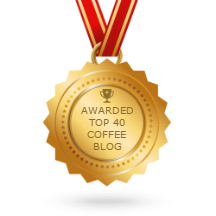This was heightened for me reading a sound byte by Robert Passikoff of Brand Keys, a New York City (marketing?) consulting firm. He said, “”It’s just good marketing. If virtually half the people say that the more European, heavier-tasting coffee is not to their liking, why not (do it)?” I could take Mr Passikoff to task for calling it more European – not, the Starbucks roast originated in San Francisco (and Alfred Peet). But, what makes me bristle more is calling it marketing. It might be paying attention to consumer trends but that is not marketing.
Good marketing is leading. Roasters such as George Howell, Oren’s Daily Roast, Counter Culture and Intelligentsia are light roast’s marketing champs. They forged ahead when angel investment groups would have looked cross-eyed that any small-time coffee guys were bucking the Starbucks “secret sauce”, the black roasted product with umami (savoriness). Starbucks marketing was so good so early and it convinced people that overroasted coffee was a virtue, that the only reason it was light roasted was to save weight loss during roasting. Still, sometimes people unchurched in the nomenclature of the coffee industry would simply say Starbucks was too strong, and this was even true among some specialty coffee folks.
Coffee strength alone was never the real problem with Starbucks, although it might seem like it at first glance. Many years ago, after Starbucks first came to rule the Evil Empire of consumer coffee, they attempted briefly to follow the Specialty Coffee Association’s hefty brewing formulas. Consumers collectively gagged and, again in a response to consumers, Starbucks hastily backed off in the brew basket. They made it less strong, but it might be argued that consumers were less in angst about the strength than that they were really tasting the stuff for the first time under the full-strength taste spotlight. The reality and the the real problem was roast. Starbucks came out a while back with a Pikes Roast, which attempted to bring their roast up a few notches lighter. It goes to show just how dark was Starbucks roasting that some, including me, were unable to appreciate Pikes as anything approaching a light roast.
The coffee business likes to pat itself on the back for marketing. It’s as if it doesn’t really believe in its product and are privately saying, “Can you believe people actually like this stuff”? There are two areas where the market (not to say “marketing”) has gone and in both these directions, Starbucks is a follower. So-called slow brew methods, such as Chemex, Hario and other drip techniques have replaced espresso with coffee aficionados. Truthfully, Starbucks never sold espresso anyway but café lattes. Slow brew means filtered coffee, which is really the specialty coffee world’s “special sauce”. Not only is Starbucks burning off the most prized flavors in their roast. They finish it off using an espresso machine. Espresso was invented as a socialist experiment to shorten the Italian coffee break and to bring forth flavors from some of the world’s least costly coffees, not exactly in lock step with the flavor seduction a Chemex can achieve with high-end beans.
Lately, espresso has become the proletariat drink and single-origin slow-brew drip the beverage choice of the literati. Witness Oliver Strand’s precious New York Times columns. Slow brew drip using some single family farm’s beans is cool. This movement was started by high-end consumers, independent farmers who learned to market their coffees using direct trade and, lastly, those high-end coffee guys previously named who stuck it out after Starbucks had attacked them and taken a good portion of their market share. Now consumers flock to them and places like Grumpys, Blue Bottle, Stumptown, all delivering a much lighter roast, and most highlighting the virtues of a small personal pot of coffee brewed per guest or couple.
Meanwhile, Starbucks has done a great job creating community centers. They are modern suburbia’s equivalent of Target, with the same uniformity. They can rightfully claim to have invented or at least won in this competition. The new roast is different. It will allow consumers to have it their way, which is a lighter way. I wish Starbucks well in joining them with the Blonde roast. It might be considered flexible and a smart response. But, it was not a marketing coup.
©2011 Kevin Sinnott All rights reserved.



Just saying – Perhaps Starbucks would like to do with the European image of burnt Roast the same that we do with burnt toast. LOL – Light Roast would certainly offset that image. Just from a non marketing, non coffee drinker’ s view, of no consequence whatever. I did try Starbucks once in an airport in desperation after 12 hour delay, and it really got my feet going, but have not been tempted to do it again. After boarding the flight and realizing that I couldn’t turn off the coffee – Oh misery in that little seat and no leg room and a 5 hour flight ahead of me. If I’m ever tempted again, I guess Starbucks, which is so readily available, could be my drug of choice. I walked from my departure gate to my destination gate! Across the Atlantic. And never got my feet damp.
I have a friend from Ireland who absolutely adores what she calls “gas station” coffee, because it is so strong and old? She won’t say, but it does seem to perk her up really fast. I believe she once told me her family in Waterford, Ireland, would sometimes boil their coffee? Ugh, sounds like boiled dirt. I wish I could get her to Chicago and let her taste your brew, and maybe I could stop looking for old gas stations. Or perhaps she could sell Starbucks on Gas Station Coffee and a marketing ploy so I didn’t have to look so hard for an old fashioned gas station – which we all know doesn’t exist any more. But I’ve found the same source in the waiting rooms of service depts. of car dealerships. Why doesn’t Starbucks look at this for a source of revenue? Just a thought. Have a super Friday.
That’s an interesting point that Starbucks hasn’t used any real marketing strategy, but has instead followed the collective swaying of the market. Dark roasts have become so fashionable (something to which I would give Starbucks most of the credit) that it will be really interesting to see how lighter roasts perform in Starbucks’ environment.
With Stumptown expansions and the like, do you think it is possible that Starbucks is now seeing a real need to expand their offerings to match companies like Intelligentsia, Counter Culture, and Stumptown?
I’m curious if you think Starbucks is broadening its horizons for the sake of diversity, or because some of those once ‘small time coffee guys’ have gained so much ground in later years.
Hi Peter, Yes you’ve got it. I think Starbucks is now playing catch up with the public’s shift to lighter roasts. The trouble for them might be lighter roasts really do spotlight bean quality. This means it will cost Starbucks more to offer good tasting coffee at the light end of the roast spectrum. Also, like it or not, it shows they aren’t leading any more. Kind of like when Sony brought out VHS machines following their Betamax failure. I still want to try it and still hope it tastes good.
Good point, Yves. Hadn’t considered that as part of the equation on what a sensible location for one (or generally more) stores could be.